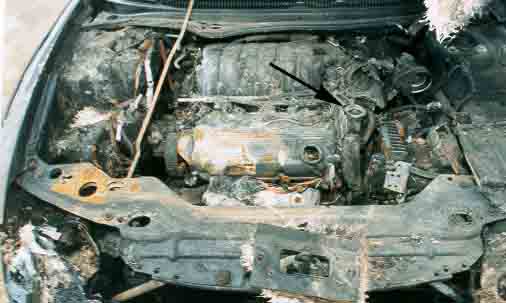Automobile engine coolant related fires may result from engine coolant leakage, an increase in the concentration of the glycol in the water/glycol mixture, the nature of the vapor/particle distribution, and contact with an ignition source in the engine compartment. Ethylene glycol, a common coolant, is a flammable liquid with an ignition temperature near 800F. In recent years, propylene glycol is being used because of environmental reasons. Propylene glycol is also a flammable liquid with an ignition temperature near 700F. In an automotive application, the glycol is mixed with water at about a 50/50 ratio. Ignition of this concentration of coolant is difficult because of the water. When released at high temperatures into the atmosphere where the water evaporates, the glycol vapor/liquid droplets can reach the state of an ignitable mixture. Typical ignition sources in the engine compartment include hot surfaces (exhaust manifold, exhaust system) and electrical components (relays, distributor, spark plug wires). Automobile accidents, resulting in hot vapor expulsion from the coolant system, are also known to cause fires.

Figure 1

Figure 2
Figure 2 is a closer view of the engine compartment with the hood raised. Inspection revealed an open engine coolant system cap as indicated by the arrow in Figure 2 and shown in detail in Figure 3. Apparently, the radiator coolant system cap was not found secured to the flange assembly.

Figure 3

Figure 4
FOR TECHNICAL ARTICLES CONTACT CLAIMS MAGAZINE AND ASK
FOR A REPRINT OF A PAST TECHNICAL NOTEBOOK ARTICLE
CLAIMS MAGAZINE
BACK TO C. ROBERTS CONSULTING ENGINEERS HOME PAGE,
WWW.CROBERTS.COM
WWW.CROBERTS.COM